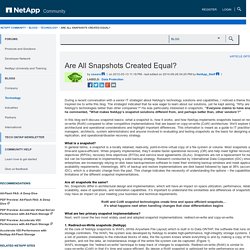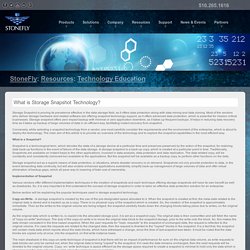

Business Continuity Knowledge Share p. 24. Difference between copy on access and precopy with differential in timefinder clone. If you terminate your clone session regardless of what parameters you used, everything begins from scratch.

Here are a couple of notes from SE TImefinder guide Fully copying to a clone Starting with Solutions Enabler version 7.0.0.370, the –copy option is specified by default. When the copy session is activated, data begins background copying so that a full copy of the data will become available on the target device. Copying, the state of the device pair is CopyInProgress; when the operation completes, the state goes to Copied. Target host can access the data. Available immediately to the target host. Creating a session in nocopy mode To create a copy session without a full background copy, you must use the -nocopy option. Is CopyOnAccess. That have been written to the source or written/read from the target will be copied to the target device. Device tracks are accessed or written to while participating in the active session. occurs to the target device, new data is written to the target device. Copy-on-write. Programming technique for efficiently duplicating data Copy-on-write (COW), sometimes referred to as implicit sharing[1] or shadowing,[2] is a resource-management technique used in computer programming to efficiently implement a "duplicate" or "copy" operation on modifiable resources.[3] If a resource is duplicated but not modified, it is not necessary to create a new resource; the resource can be shared between the copy and the original.

Modifications must still create a copy, hence the technique: the copy operation is deferred until the first write. By sharing resources in this way, it is possible to significantly reduce the resource consumption of unmodified copies, while adding a small overhead to resource-modifying operations. h10858-vnx-snapshots-wp.pdf. Peterson-UCSC-MS02.pdf. Oracle Storage Guy: New Asynchronous Copy on First Write (ACoFW) Eliminates Snapshot Write Penalty. In one of my previous posts in this blog I covered the different types of snapshots and their effect on storage performance.

Basically, snapshots fall into two categories: Metadata based snapshots which have no write penalty but extract a read penalty due to the sequential read after random write (SRaRW) issue. Reserve LUN Pool (RLP) based snapshots which have no read penalty but extract a write penalty due to the Copy on First Write (CoFW) issue. It is noteworthy that NetApp is well known for its metadata based snapshots using the WAFL file system, and EMC is well known as being a leader in the RPL based snapshots space. I have recently learned that EMC has now largely solved the CoFW performance penalty, using a new feature called Asynchronous Copy on First Write (ACoFW). ACoFW works like this: The storage array marks a write track as "versioned write pending", and accepts it without a CoFW penalty to the host.
As usually, there is no free lunch. Are All Snapshots Created Equal? - NetApp Community. During a recent conversation with a senior IT strategist about NetApp's technology solutions and capabilities, I noticed a theme that inspired me to write this blog.

The strategist indicated that he was eager to learn about our solutions, yet he kept asking, “Why are NetApp's technologies better than other companies’?” He was particularly interested in snapshots. “Everyone claims to have snapshots" he commented, "What makes NetApp’s snapshot solutions different from, and perhaps better than, other vendors’?” In this blog we’ll discuss snapshot basics -what a snapshot is, how it works, and how NetApp implements snapshots based on redirect-on-write (RoW) compared to other competitive implementations that are based on copy-on-write (CoW) architecture. We’ll explore key architectural and operational considerations and highlight important differences. Redirect-on-Write. Unfortunately, I am having a COW about it! Storage Snapshot Technology - StoneFly's iSCSI.com. Storage Snapshot is proving its prevalence effective in the data storage field, as it offers data protection along with data mining and data cloning.

Most of the vendors who deliver storage hardware and related software are offering snapshot technology support, as it offers advanced data protection, which is essential for mission critical businesses. Storage snapshot offers zero impact backup with minimal or zero application downtime, as it takes up frequent backups. It helps in reducing data recovery time as it takes up backup of large volumes of data in an efficient way, facilitating instant recovery from snapshot.
Conversely, while selecting a snapshot technology from a vendor, one must carefully consider the requirements and the environment of the enterprise, which is about to deploy the technology. The main aim of this article is to provide an overview of the technology and to explore the snapshot capabilities in the most efficient way.
Understanding and exploiting snapshot technology for data protection, Part 1: Snapshot technology overview.